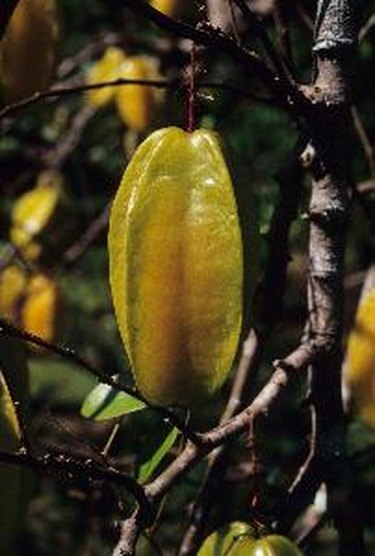
Florida has six USDA growing zones, from 8a through 10b. Although it has a subtropical climate, there are low-chill varieties of many of the colder-climate fruits such as stone fruits, apples and pears, that do well in Florida. Add to this the subtropical and tropical fruits that grow in South Florida and the cold-hardy varieties of fruits, such as bananas, that can grow in more temperate areas of the state. The list of possibilities is long and what fruit you grow depends mainly on where you live and how much work you are willing to put into growing your favorite fruits.
About Chill Hours
Video of the Day
Chill hours refers to the total number of hours below 45 degrees Fahrenheit accumulated through the winter. Even in the Florida Panhandle, the 400 to 650 chill hours do not meet the criteria for most of the better-known commercial varieties of apples, pears or stone fruits. The University of Florida has developed several varieties of these fruits that require far fewer chill hours and can be grown successfully in all but the southernmost areas of the state.
Video of the Day
Low-Chill Fruits
Low-chill fruits are varieties that require far fewer chill hours than normal commercial varieties. The University of Florida has bred or introduced varieties of apples, berries, pears and peaches that perform well in Florida, such as the "Anna" apple introduced from Israel in 1967 and "Tropic Sweet" apple developed at the Florida Agricultural Experiment Station. Northern highbush blueberries were crossed with Florida native wild blueberries to produce southern highbush blueberries, released in the mid-1970s and improved since then. Peaches such as "Tropicbeauty," "Flordaglo" and "Flordaprince" can be grown in south Florida. "Mysore" raspberries and "Brazos" blackberries are two widely-grown south Florida varieties. Attempts to breed nectarines, sweet cherries and bunch grapes for South Florida have been unsuccessful but are ongoing.
Subtropical and Tropical Fruits
The most widely-grown subtropical and tropical fruits in Florida are bananas, avocados and mangos, but this is only a handful of what can be grown. Other subtropical fruits include carambola (starfruit), loquat, lychee, pitaya (dragon fruit), sapotes and jaboticaba. Tropical fruits include Barbados cherry, coconut palm, jackfruit, Surinam cherry, papaya, pineapple, passion fruit and sapodilla. Citrus is a common dooryard fruit in Florida and has cold-hardy varieties that can be grown in the panhandle, as well as the subtropical and tropical varieties for warmer USDA zones.
Temperate Fruits
The central and northern areas of Florida are able to grow more temperate fruits. Rabbiteye blueberries, blackberries, raspberries, bunch grapes and figs thrive in the cooler summers and colder winters of north and central Florida. Many pears and persimmons as well as plums and pomegranates are available for home gardeners. Low-chill varieties of apples, peaches, nectarines are available. Native fruits such as common persimmon and muscadine grapes are often grown in central and north Florida landscapes.